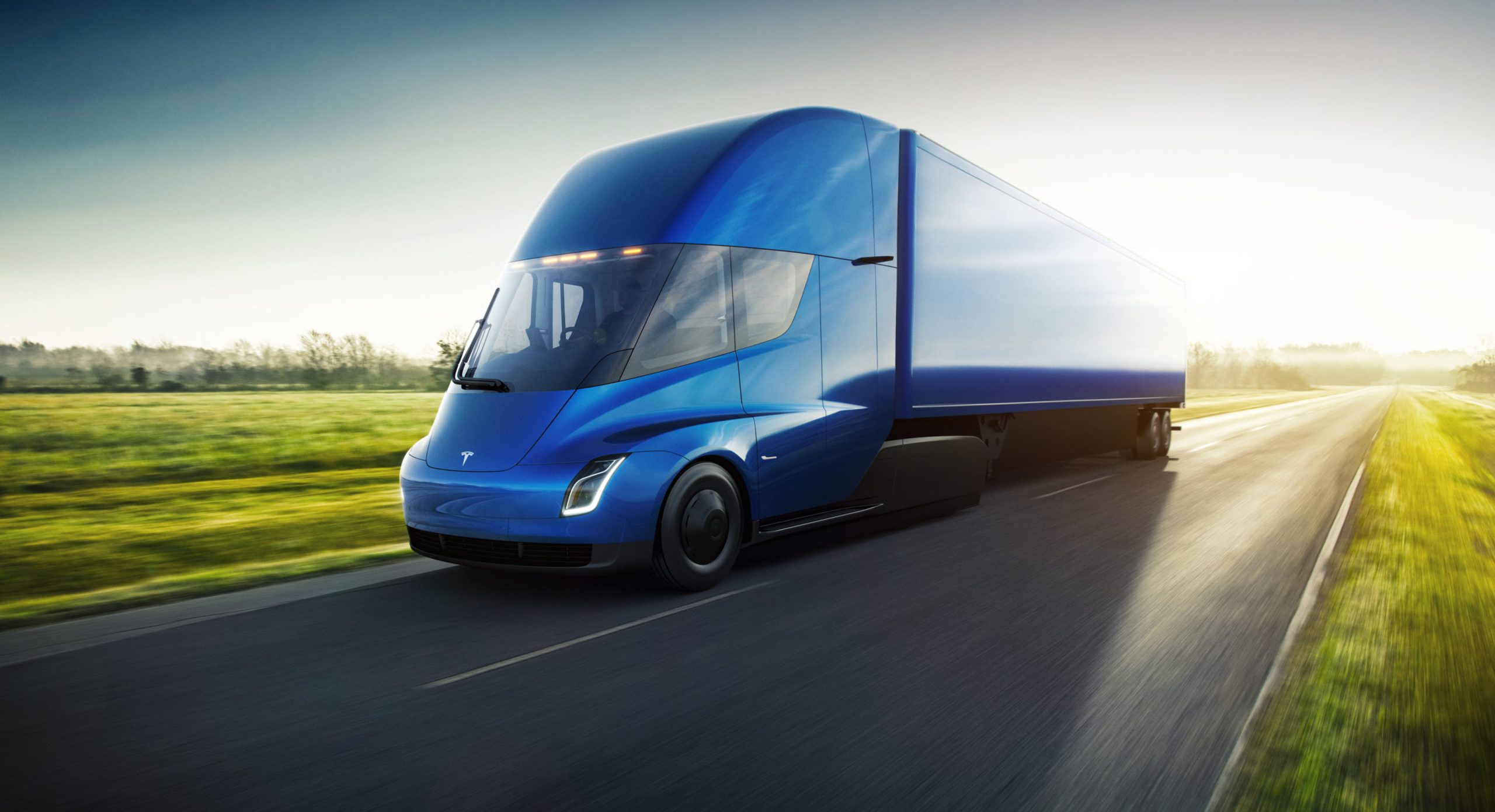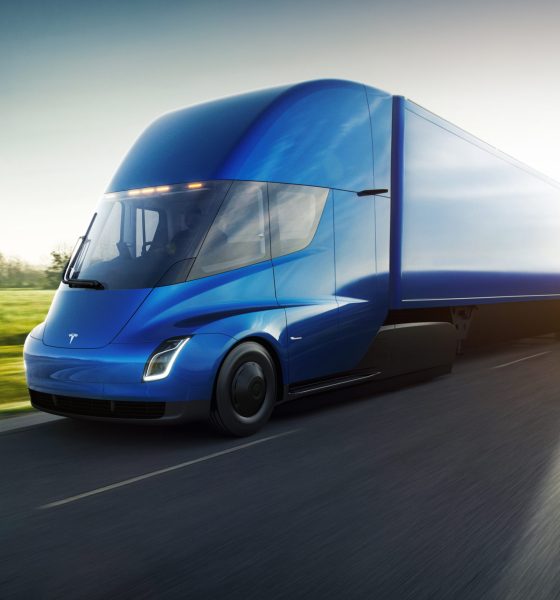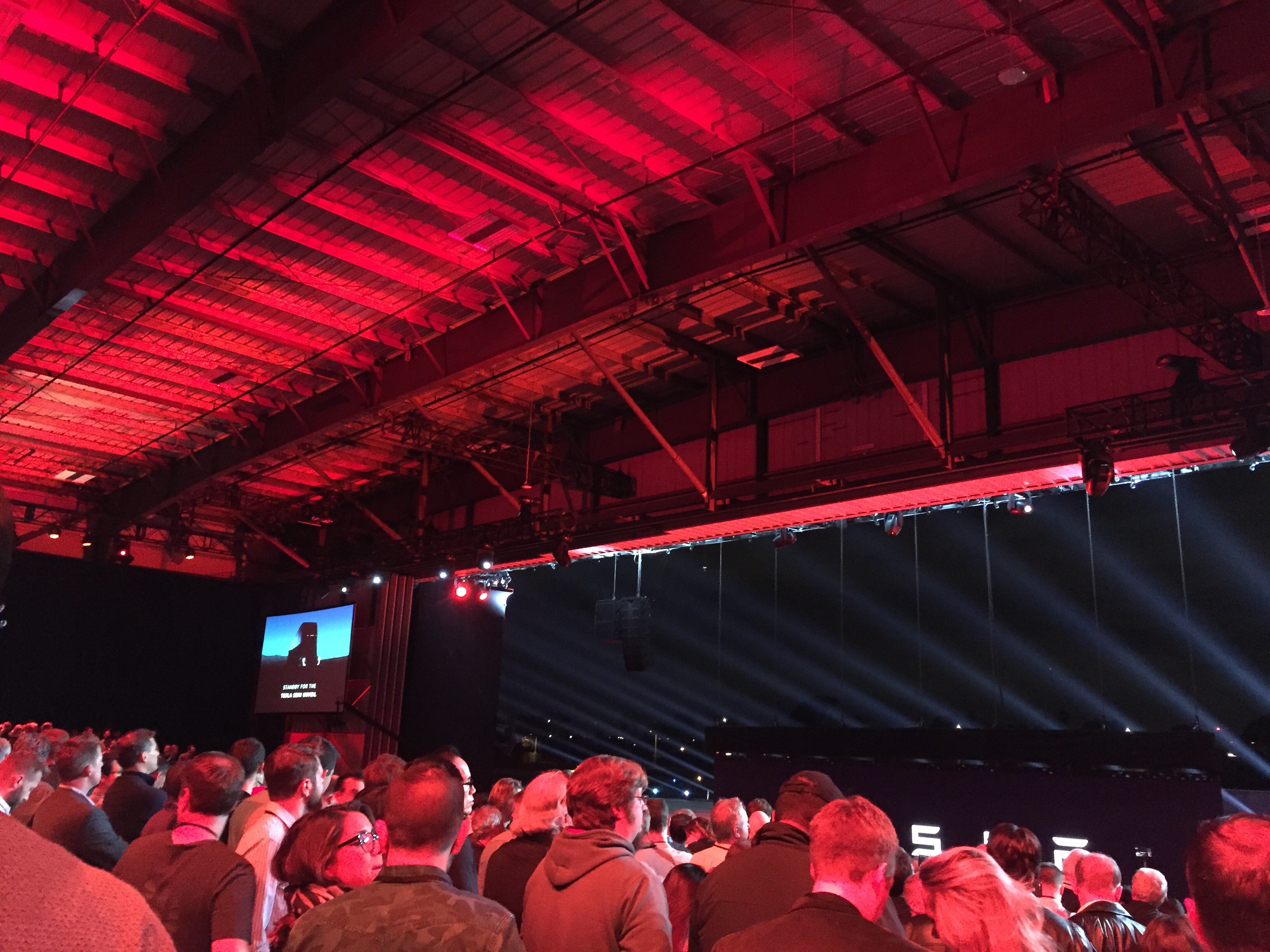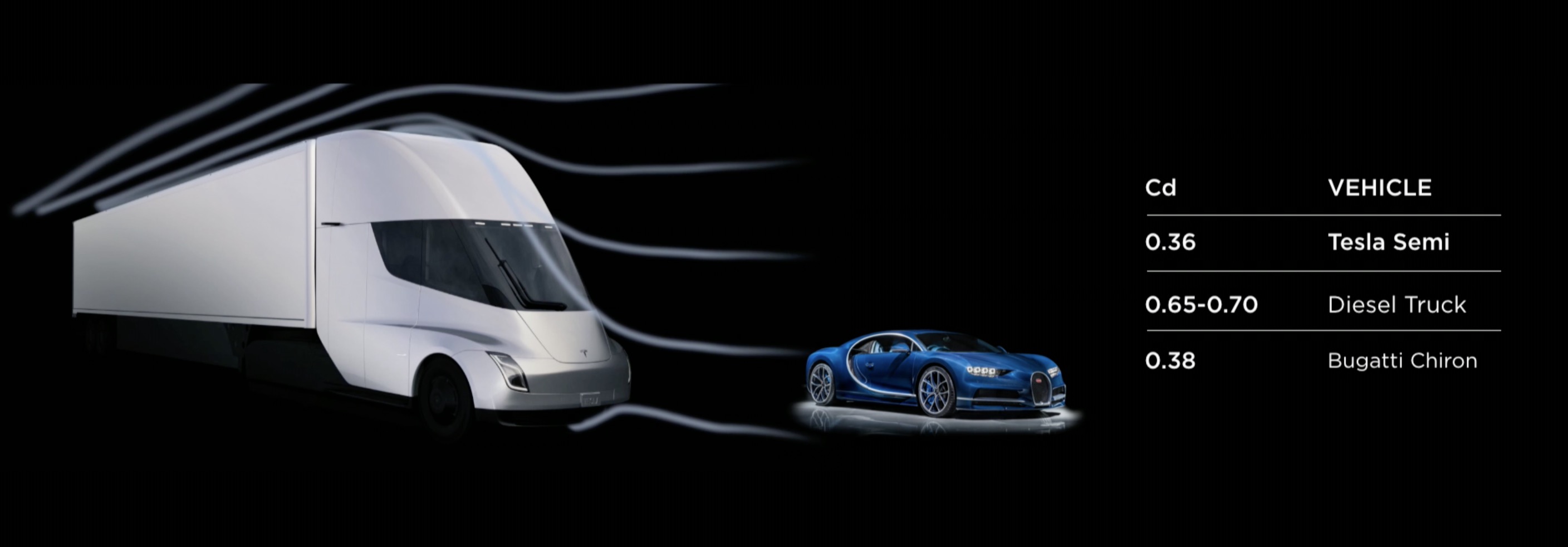

News
Tesla Semi Unveiled: 500+ mile range, Bugatti-beating aero, 2019 production
Tesla CEO Elon Musk unveiled the company’s highly anticipated semi-truck Thursday night on an airport hangar adjoining the company’s Design Center in Hawthorne, CA. It’s the California-based electric car maker’s first foray into the commercial trucking industry.
Before a packed crowd of thousands, Musk revealed industry-disrupting details of the Tesla Semi.
The Tesla Semi can accelerate from 0-60 in 5 seconds, without cargo, and 20 seconds with a full 80,000 lb. load, more than twice as quick as a traditional diesel truck. The Semi can also traverse a 5% gradient at 65mph, compared to 45mph for diesel trucks. This is all powered by the truck’s four independent electric motors says Musk. “You can lose two of the four motors, and the truck will still keep going. In fact, even if you have only two of the four motors active it will still beat a diesel truck.”

Tesla Semi-Reveal before the big curtain drop (Photo: Teslarati)
In addition, the Tesla Semi has a .36 drag coefficient, compared to the standard of .65-.70. Musk compared it to a Bugatti, noting that the semi-truck beats the supercar’s .38 drag coefficient. “Overall, the Semi is more responsive, covers more miles than a diesel truck in the same amount of time, and more safely integrates with passenger car traffic,” says Tesla in its official announcement. The company also highlighted the fact that the Semi benefits tremendously from the regenerative braking that can recapture 98% of braking energy into the battery.
The Tesla Semi’s development has been led by Jerome Guillen, VP of Trucks and Programs. He has led the development of the truck since January 2016, and prior to his current role was VP of Worldwide Sales and Service and was the Model S’s Program Director & VP of Vehicle Engineering. While it may seem odd that Guillen jumped from Sales and Service to leading the development of an all-electric semi-truck, it’s worth noting that before joining Tesla, he was Director of Business Innovation at Daimler and General Manager of Freightliner (Large manufacturer of class 8 diesel semi-trucks, owned by Daimler).
Musk also pointed out that it takes 15 minutes for traditional diesel-powered semi-trucks to fuel up, where as a Tesla Semi can charge 400 miles in 30 minutes, which is provided by “Megachargers“. The Megachargers run on solar power and Tesla has guaranteed electricity rates of $0.07 per kWh with Semi owners.
- The Tesla Semi’s interior. (Credit: Tesla)
The interior of the Tesla Semi has one seat positioned in the center and provides drivers with unparalleled visibility. The seat is surrounded by two touchscreens that reminisce the ones found in the Model 3 sedan. Tesla’s semi-truck will also be equipped with Enhanced Autopilot which Musk notes will provide safety by automatically pulling over and stopping when truckers are in danger.
The Semi also has a small front truck, “because why not”, said Musk. The glass windshield on the Semi is thermonuclear resistant glass, which Musk says is a big deal because semi-trucks often have their windshields crack twice a year (which renders the truck undrivable). It can be assumed that this incredible glass could be related to Tesla’s nearly indestructible Solar Roof glass development.
Tesla claims that the semi will cost 20% less per mile compared to diesel trucks, costing $1.26/mile versus $1.51/mile . But that wasn’t all. Musk announced convoy technology that will further reduce the cost per mile driven for the Tesla Semi, even beating the cost of rail-based transportation.
“Tesla Semi can also travel in a convoy, where one or several Semi trucks will be able to autonomously follow a lead Semi.”
While Tesla didn’t unveil the price of the Semi, Musk noted that the semi-truck is expected to save operators $200k on fuel alone over 1 million miles. This resonated with fleet owners as Jerome Guillen pointed to some important guests at the event, stating that they had “placed a lot of reservations”. First production of the Tesla Semi is expected sometime in 2019.

News
Nvidia CEO Jensen Huang explains difference between Tesla FSD and Alpamayo
“Tesla’s FSD stack is completely world-class,” the Nvidia CEO said.

NVIDIA CEO Jensen Huang has offered high praise for Tesla’s Full Self-Driving (FSD) system during a Q&A at CES 2026, calling it “world-class” and “state-of-the-art” in design, training, and performance.
More importantly, he also shared some insights about the key differences between FSD and Nvidia’s recently announced Alpamayo system.
Jensen Huang’s praise for Tesla FSD
Nvidia made headlines at CES following its announcement of Alpamayo, which uses artificial intelligence to accelerate the development of autonomous driving solutions. Due to its focus on AI, many started speculating that Alpamayo would be a direct rival to FSD. This was somewhat addressed by Elon Musk, who predicted that “they will find that it’s easy to get to 99% and then super hard to solve the long tail of the distribution.”
During his Q&A, Nvidia CEO Jensen Huang was asked about the difference between FSD and Alpamayo. His response was extensive:
“Tesla’s FSD stack is completely world-class. They’ve been working on it for quite some time. It’s world-class not only in the number of miles it’s accumulated, but in the way it’s designed, the way they do training, data collection, curation, synthetic data generation, and all of their simulation technologies.
“Of course, the latest generation is end-to-end Full Self-Driving—meaning it’s one large model trained end to end. And so… Elon’s AD system is, in every way, 100% state-of-the-art. I’m really quite impressed by the technology. I have it, and I drive it in our house, and it works incredibly well,” the Nvidia CEO said.
Nvidia’s platform approach vs Tesla’s integration
Huang also stated that Nvidia’s Alpamayo system was built around a fundamentally different philosophy from Tesla’s. Rather than developing self-driving cars itself, Nvidia supplies the full autonomous technology stack for other companies to use.
“Nvidia doesn’t build self-driving cars. We build the full stack so others can,” Huang said, explaining that Nvidia provides separate systems for training, simulation, and in-vehicle computing, all supported by shared software.
He added that customers can adopt as much or as little of the platform as they need, noting that Nvidia works across the industry, including with Tesla on training systems and companies like Waymo, XPeng, and Nuro on vehicle computing.
“So our system is really quite pervasive because we’re a technology platform provider. That’s the primary difference. There’s no question in our mind that, of the billion cars on the road today, in another 10 years’ time, hundreds of millions of them will have great autonomous capability. This is likely one of the largest, fastest-growing technology industries over the next decade.”
He also emphasized Nvidia’s open approach, saying the company open-sources its models and helps partners train their own systems. “We’re not a self-driving car company. We’re enabling the autonomous industry,” Huang said.
Elon Musk
Elon Musk confirms xAI’s purchase of five 380 MW natural gas turbines
The deal, which was confirmed by Musk on X, highlights xAI’s effort to aggressively scale its operations.

xAI, Elon Musk’s artificial intelligence startup, has purchased five additional 380 MW natural gas turbines from South Korea’s Doosan Enerbility to power its growing supercomputer clusters.
The deal, which was confirmed by Musk on X, highlights xAI’s effort to aggressively scale its operations.
xAI’s turbine deal details
News of xAI’s new turbines was shared on social media platform X, with user @SemiAnalysis_ stating that the turbines were produced by South Korea’s Doosan Enerbility. As noted in an Asian Business Daily report, Doosan Enerbility announced last October that it signed a contract to supply two 380 MW gas turbines for a major U.S. tech company. Doosan later noted in December that it secured an order for three more 380 MW gas turbines.
As per the X user, the gas turbines would power an additional 600,000+ GB200 NVL72 equivalent size cluster. This should make xAI’s facilities among the largest in the world. In a reply, Elon Musk confirmed that xAI did purchase the turbines. “True,” Musk wrote in a post on X.
xAI’s ambitions
Recent reports have indicated that xAI closed an upsized $20 billion Series E funding round, exceeding the initial $15 billion target to fuel rapid infrastructure scaling and AI product development. The funding, as per the AI startup, “will accelerate our world-leading infrastructure buildout, enable the rapid development and deployment of transformative AI products.”
The company also teased the rollout of its upcoming frontier AI model. “Looking ahead, Grok 5 is currently in training, and we are focused on launching innovative new consumer and enterprise products that harness the power of Grok, Colossus, and 𝕏 to transform how we live, work, and play,” xAI wrote in a post on its website.
Elon Musk
Elon Musk’s xAI closes upsized $20B Series E funding round
xAI announced the investment round in a post on its official website.

xAI has closed an upsized $20 billion Series E funding round, exceeding the initial $15 billion target to fuel rapid infrastructure scaling and AI product development.
xAI announced the investment round in a post on its official website.
A $20 billion Series E round
As noted by the artificial intelligence startup in its post, the Series E funding round attracted a diverse group of investors, including Valor Equity Partners, Stepstone Group, Fidelity Management & Research Company, Qatar Investment Authority, MGX, and Baron Capital Group, among others.
Strategic partners NVIDIA and Cisco Investments also continued support for building the world’s largest GPU clusters.
As xAI stated, “This financing will accelerate our world-leading infrastructure buildout, enable the rapid development and deployment of transformative AI products reaching billions of users, and fuel groundbreaking research advancing xAI’s core mission: Understanding the Universe.”
xAI’s core mission
Th Series E funding builds on xAI’s previous rounds, powering Grok advancements and massive compute expansions like the Memphis supercluster. The upsized demand reflects growing recognition of xAI’s potential in frontier AI.
xAI also highlighted several of its breakthroughs in 2025, from the buildout of Colossus I and II, which ended with over 1 million H100 GPU equivalents, and the rollout of the Grok 4 Series, Grok Voice, and Grok Imagine, among others. The company also confirmed that work is already underway to train the flagship large language model’s next iteration, Grok 5.
“Looking ahead, Grok 5 is currently in training, and we are focused on launching innovative new consumer and enterprise products that harness the power of Grok, Colossus, and 𝕏 to transform how we live, work, and play,” xAI wrote.













